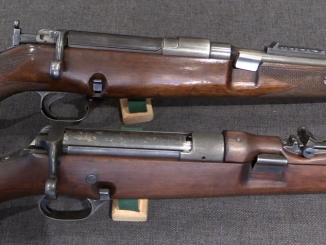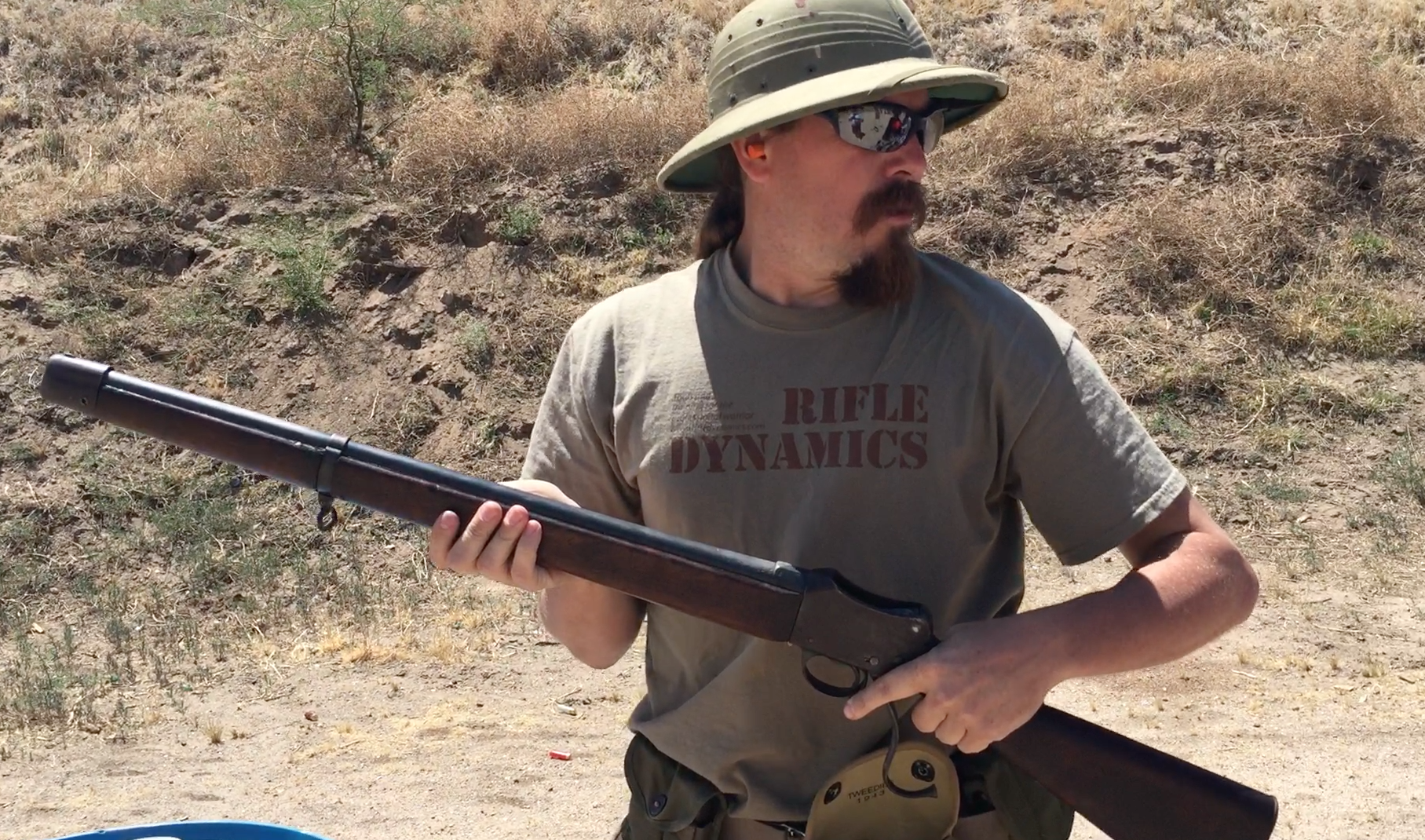In addition to building three main patterns of straight-pull bolt action rifle for the Canadian military and the commercial market, Sir Charles Ross also experimented with self-loading rifles. Starting with a standard Ross Mk III, this experimental rifle has a gas piston and trigger to allow automatic fire and a very neat forced-air cooling system. A one-way rather mechanism (now broken, unfortunately) spins the fan when the bolt cycles, pushing air into a barrel shroud similar to that of a Lewis gun. This rifle was most likely made in 1915 or 1916 with an eye to a military light machine gun or automatic rifle contract – which never happened.
Thanks to the Canadian War Museum for providing me access to film this Ross for you!




Fan on a rifle? Never seen before or after.
There is a very good reason why cooling fans generally do not get stuck on guns: more stuff to go horribly wrong if someone fails to clean properly. How would you deal with mud or pratfalls?!
I don’t think it’s too bad of an idea to have a fan. It just needs a better air filter in front of it, and a quick change system.
“Fan on a rifle? Never seen before or after.”
Wait, but this is machine gun or it is not?
And if it yes it was NOT sole idea of combining machine gun AND cooling see – for another design employing cooling fan see Patent US1328230A by James S Johnston
https://patents.google.com/patent/US1328230
he later designed more convention machine gun, see photos:
https://www.historicalfirearms.info/post/153793182127/johnston-d-1918-light-machine-gun-in-the-first
Same here. Neat idea. But sounds like one of those ideas that works way better in the lab than in the field.
Still, pretty cool concept. If they could manage the same air flow with no moving parts, it would have potential.
The Lewis gun shroud does generate some airflow around the barrel by a combination of convection and muzzle blast. It’s not a lot since stripped Lewis guns in naval use didn’t have significant cooling problems.
I can’t think of any reasonable way to cool a gun with forced air without moving parts, which explains the modern preference for Gatling style rotary barrels since the time between shots allows adequate cooling.
“(…)way to cool a gun with forced air without moving parts(…)”
See Pecheneg:
https://modernfirearms.net/en/machineguns/russia-machineguns/pecheneg-eng/
Ah, that old chestnut.
The Lewis air cooling system does work.
If you take an aeroplane Lewis and use it as a ground AA gun, or as an AA gun on a ship (the latter travelling at some speed usually in the North Atlantic, ie a cold wet environment) or stick a stock on it and give it to the Home Guard as an LMG who only get to fire one mag a year in training and are never used in combat, then it’s fine. In the ground AA role it is lucky to get off one or two mags before the threat has flown away. In the same role, a Bren or GPMG would not need a barrel change, because they are nowhere near firing 180-200 rounds per barrel in short order. Even a BAR would do fine.
The Lewis air-cooling system is not the right answer. Quick-change barrels are. But this whole thing in books and on the internet suggesting that the Lewis air-cooling system did not work or was unnecessary is, er, bollocks.
Interestingly Lewis-style air cooling system was apparently mated to Browning Machine Gun Caliber .30, T5 (Heavy) see photo:
https://www.historicalfirearms.info/post/187174991984
outcome/observations regarding firing this weapon are sadly unknown for me.
“But this whole thing in books and on the internet suggesting that the Lewis air-cooling system did not work or was unnecessary is, er, bollocks.”(С)
Of course it works. 😉
How much does a radiator weigh?
2-2.5 kg?
Just increase the barrel weight by this amount and get the same result.
And maybe the best.
very steampunky!
“(…)steampunky(…)”
If you does like it, I have idea for matching mode of transportation for you:
https://silodrome.com/brennan-helicopter/
It won’t pass the In Range mud test!
Will also fail the dust test!
Astonishing (Ross continues to surprise – is there any decent book, on line source etc. on it that covers these, that wont cost an arm and a leg?).
Surely the key thing is – did it work. There have been numerous seemingly bizarre designs that went on to be lauded as exemplary. Though in this case, as not adopted (though the semi-auto ‘market’ at the time a minefield of prejudices, special interests and other factors), it seems not – or at least not sufficiently well. History is a cruel judge.
If you put a “Washer” around the barrel; which would act, as if to be airtight’ish… A piston head, type thing. That sat infont of the intake for this fan, and said washer was attached to a NiTi spring at the front; running up to the muzzle, where it would also be attached. Then heat from the gas port could contract the spring, and thus pull the “washer” up the barrel in doing so, spinning the fan as it drew air into the barrel… Then a return spring would extend it back. I doubt that would happene quick enough, but NiTi could probably be used in some form of barrel cooling mech; maybe even heat exchange, as it is doing work… Can’t say I understand that entirely, but if I had one I would certainly fiddle around with it via a hacksaw a hammer and other tools.
Good stuff that Nitinol for guns I think; if you fiddled around.
Got chilli/pepper in my eye then, my glasses fell off. Ion wind; Americium-241, nuclear barrel? No. I had washed my hands but clearly not enough for minor contact with a sensitive area.
“(…)NiTi(…)”
What is thermal conductivity when compared to steel (or iron)?
No idea, but it “works” with heat, so like…
I don’t know, but by “working” wouldn’t that take heat away via it doing work… I don’t know, hence my suggestion of hit with a hammer.
Cool find!
Too bad there is so little documentation.
We wonder Iran. Huot worked on this prototype?
Cool find!
Too bad there is so little documentation.
We wonder if M. Huot worked on this prototype?
“…There have been numerous seemingly bizarre designs that went on to be lauded as exemplary…”(С)
It seems to me that in the US (and not only) between the great wars they tried everything they could.
https://strangernn.dreamwidth.org/1726657.html
https://i.pinimg.com/originals/de/de/f5/dedef57322cfbc74a67bd5257298a3f0.png
https://www.deviantart.com/madmax6391/art/Autorifle-Fedorov-Degtyarev-190353725
Some, however, were too keen on…
https://i.redd.it/vwf2w109tr231.png
But those who succeeded quickly realized that the barrel is best cooled by water. And if by air, then it should be as massive as possible.
Everything else is not effective, if it works at all.